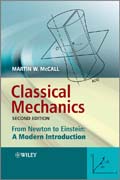
Classical mechanics: from Newton to Einstein : a modern introduction
McCall, Martin
"Classical Mechanics" provides a clear introduction to the subject, combininga user-friendly style with an authoritative approach, whilst requiring minimal prerequisite mathematics - only elementary calculus and simple vectors are presumed. The text starts with a careful look at Newton's Laws, before applyingthem in one dimension to oscillations and collisions. More advanced applications - including gravitational orbits, rigid body dynamics and mechanics in rotating frames - are deferred until after the limitations of Newton's inertial frames have been highlighted through an exposition of Einstein's Special Relativity. This title offers comprehensive yet concise introduction to classical mechanics and relativity. It emphasizes real life examples. It includes many interesting problems and a key revision notes chapter. Presented in a style that assumes a minimum of mathematical knowledge, it contains new chapter on computational dynamics. It features unique mixture of classical mechanics with relativity. It also includes supplementary web link and solutions manual INDICE: Preface to Second Edition. Preface to First Edition. 1 Newton'sLaws. 1.1 What is Mechanics? 1.2 Mechanics as a Scientific Theory. 1.3 Newtonian vs. Einsteinian Mechanics. 1.4 Newton's Laws. 1.5 A Deeper Look at Newton's Laws. 1.6 Inertial Frames. 1.7 Newton's Laws in Noninertial Frames. 1.8 Switching Off Gravity. 1.9 Finale Laws, Postulates or Definitions? 1.10 Summary. 1.11 Problems. 2 One-dimensional Motion. 2.1 Rationale for One-dimensional Analysis. 2.2 The Concept of a Particle. 2.3 Motion with a Constant Force. 2.4 Work and Energy. 2.5 Impulse and Power. 2.6 Motion with a Position-dependent Force. 2.7 The Nature of Energy. 2.8 Potential Functions. 2.9 Equilibria. 2.10 Motion Close to a Stable Equilibrium. 2.11 The Stability of the Universe. 2.12 Trajectory of a Body Falling a Large Distance Under Gravity. 2.13 Motion with a Velocity-dependent Force. 2.14 Summary. 2.15 Problems. 3 Oscillatory Motion. 3.1 Introduction. 3.2 Prototype Harmonic Oscillator. 3.3 Differential Equations. 3.4 General Solution for Simple Harmonic Motion. 3.5 Energy in Simple Harmonic Motion. 3.6 Damped Oscillations. 3.7 Light Damping the Q Factor. 3.8 Heavy Damping and Critical Damping. 3.9 Forced Oscillations. 3.10 Complex Number Method.3.11 Electrical Analogue. 3.12 Power in Forced Oscillations. 3.13 Coupled Oscillations. 3.14 Summary. 3.15 Problems. 4 Two-body Dynamics. 4.1 Rationale. 4.2 Centre of Mass. 4.3 Internal Motion: Reduced Mass. 4.4 Collisions. 4.5 Elastic Collisions. 4.6 Inelastic Collisions. 4.7 Centre-of-mass Frame. 4.8 Rocket Motion. 4.9 Launch Vehicles. 4.10 Summary. 4.11 Problems. 5 Relativity 1: Space and Time. 5.1 Why Relativity? 5.2 Galilean Relativity. 5.3 The Fundamental Postulates of Relativity. 5.4 Inertial Observers in Relativity. 5.5 Comparing Transverse Distances Between Frames. 5.6 Lessons from a Light Clock: Time Dilation. 5.7 Proper Time. 5.8 Interval Invariance. 5.9 The Relativity of Simultaneity. 5.10 The Relativity of Length: Length Contraction. 5.11 The Lorentz Transformations. 5.12 Velocity Addition. 5.13 Particles Moving Faster than Light: Tachyons. 5.14 Summary. 5.15 Problems. 6 Relativity 2: Energy and Momentum. 6.1Energy and Momentum. 6.2 The Meaning of Rest Energy. 6.3 Relativistic Collisions and Decays. 6.4 Photons. 6.5 Units in High-energy Physics. 6.6 Energy/Momentum Transformations Between Frames. 6.7 Relativistic Doppler Effect. 6.8 Summary. 6.9 Problems. 7 Gravitational Orbits. 7.1 Introduction. 7.2 Work in ThreeDimensions. 7.3 Torque and Angular Momentum. 7.4 Central Forces. 7.5 Gravitational Orbits. 7.6 Kepler's Laws. 7.7 Comments. 7.8 Summary. 7.9 Problems. 8 Rigid Body Dynamics. 8.1 Introduction. 8.2 Torque and Angular Momentum for Systems of Particles. 8.3 Centre of Mass of Systems of Particles and Rigid Bodies. 8.4 Angular Momentum of Rigid Bodies. 8.5 Kinetic Energy of Rigid Bodies. 8.6 Bats, Cats, Pendula and Gyroscopes. 8.7 General Rotation About a Fixed Axis. 8.8 Principal Axes. 8.9 Examples of Principal Axes and Principal Moments of Inertia. 8.10 Kinetic Energy of a Body Rotating About a Fixed Axis. 8.11 Summary.8.12 Problems. 9 Rotating Frames. 9.1 Introduction. 9.2 Experiments on Roundabouts. 9.3 General Prescription for Rotating Frames. 9.4 The Centrifugal Term.9.5 The Coriolis Term. 9.6 The Foucault Pendulum. 9.7 Free Rotation of a Rigid Body Tennis Rackets and Matchboxes. 9.8 Final Thoughts. 9.9 Summary. 9.10 Problems. Appendix 1: Vectors, Matrices and Eigenvalues. A.1 The Scalar (Dot) Product. A.2 The Vector (Cross) Product. A.3 The Vector Triple Product. A.4 Multiplying a Vector by a Matrix. A.5 Calculating the Determinant of a 3 × 3 Matrix. A.6 Eigenvectors and Eigenvalues. A.7 Diagonalising Symmetric Matrices. Appendix 2: Answers to Problems. Appendix 3: Bibliography. Index.
- ISBN: 978-0-470-71574-1
- Editorial: John Wiley & Sons
- Encuadernacion: Cartoné
- Páginas: 256
- Fecha Publicación: 01/10/2010
- Nº Volúmenes: 1
- Idioma: Inglés
